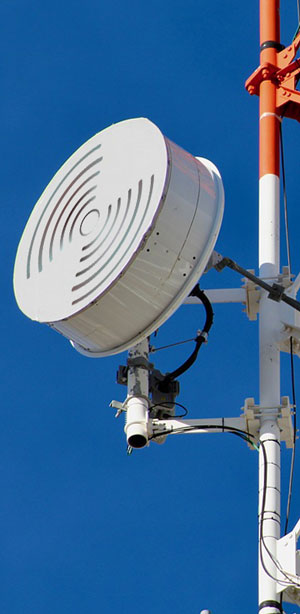By: John Shepler
To power your business systems, such as phone systems, conferencing tools, and cloud-based software, you need a lot of reliable bandwidth. Usually, fiber optic connectivity is the answer. But what if the fiber line is cut (it happens), can’t be installed quickly enough, or is too expensive to install? In these situations, if you’re in the right area, fixed wireless might be the best solution.
Cell phones provide mobile connectivity, essentially putting a phone and a small computer in our pockets. This is wireless mobility. Each phone uses a modem and radio to communicate with the nearest cell tower, seamlessly switching connections to new towers as you move. The complexity of managing these mobile signals is invisible to the user.
You might have used your phone as a Wi-Fi hotspot to connect your computer to the internet when your regular internet service was down. That’s fixed wireless in action. It’s similar to mobile wireless, but you’re not moving.
Cellular Fixed Wireless
Imagine connecting your entire network to your phone during an internet outage, not just one computer. Some phones offer this capability by acting as Wi-Fi hotspots. For small businesses, this workaround might suffice for brief periods. However, being unable to use your phone normally and potentially facing high data overage charges can be inconvenient.
Specialized fixed cellular services are designed for this very purpose. You receive a device resembling a Wi-Fi router, equipped with superior antennas compared to your phone, an Ethernet port for network connectivity, and possibly built-in Wi-Fi routing. Some models allow for external antenna mounting in areas with weak signals.
Unlike limited personal plans, these business-oriented fixed cellular services offer substantial data allowances. You can find plans with 100 GB or more, even unlimited usage options (within reasonable limits). These services leverage 4G LTE and now 5G technology to deliver the necessary speeds for business operations.
Microwave Fixed Wireless
Point-to-point microwave fixed wireless is a step up from cellular fixed wireless. Similar to older telco microwave relay systems, this technology uses a small dish or antenna installed on your building. It establishes a direct connection with the provider’s antenna, requiring a clear line of sight. This usually limits availability to metropolitan areas.
A key advantage of microwave fixed wireless is its dedicated nature for business use. This means you’re not competing with other users for bandwidth. Bandwidth options can reach speeds of 1 Gbps or even 10 Gbps and are often symmetrical, unlike cellular connections. This means upload and download speeds are equal, and your bandwidth is guaranteed. Data caps are typically not an issue.
Think of microwave fixed wireless as “fiber optic without the fiber.” This means avoiding construction disruptions and delays associated with laying fiber optic cable. Installation can take only a few days, compared to weeks or months for fiber installation, especially if your building isn’t already equipped for it.
Another benefit is potentially lower latency compared to fiber services with equivalent bandwidth. This is because the wireless signal travels directly from the provider to you, while fiber optic systems often involve longer routes and multiple switching points. Lower latency is crucial for businesses involved in activities like financial trading and improves the quality of VoIP calls, video conferencing, and cloud-based interactive processes.
While cellular broadband relies on the internet with its inherent latency and congestion issues, fixed wireless can bypass the internet altogether or connect to it as needed for customer and supplier interactions.
Why Not The Best of Both Fiber and Wireless?
The ideal setup for your business might involve a combination of fiber optic and fixed wireless services. This allows you to establish a connection quickly with fixed wireless while waiting for fiber installation.
Once both are operational, consider retaining fixed wireless as a backup for your fiber connection. Fiber outages, often caused by accidental cable cuts during unrelated construction, can take days to resolve. With automatic failover in place, your data seamlessly switches to the wireless link, minimizing disruption. The system then switches back once the fiber connection is restored.
Fixed wireless offers a truly diverse path compared to fiber, meaning simultaneous failures are unlikely. Some businesses mistakenly believe they have redundancy with multiple fiber lines or providers. However, these often run within the same conduit, making them susceptible to simultaneous outages.
If you need fast installation of high-speed internet for your business and/or a reliable backup for your existing fiber connection, consider microwave fixed wireless service for your bandwidth needs.


